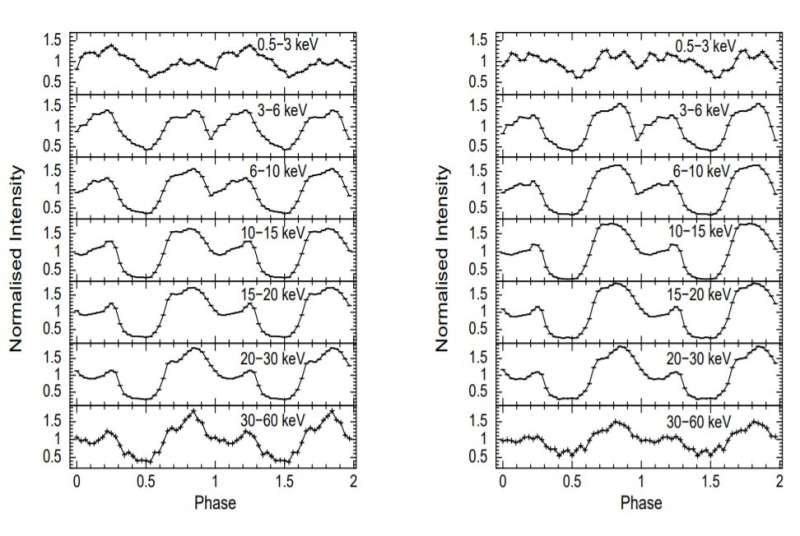July 14, 2021 report
Outburst of Cepheus X-4 pulsar inspected with AstroSat

Using the AstroSat spacecraft, Indian astronomers have observed the Cepheus X-4 X-ray pulsar during its outburst in 2018. Results of these observations provide important insights into the properties of this outburst and shed more light on the nature of the pulsar. The study was presented in a paper published July 8 on arXiv.org.
X-ray pulsars (also known as accretion-powered pulsars) are sources displaying strict periodic variations in X-ray intensity, consisting of a magnetized neutron star in orbit with a normal stellar companion. In these binary systems, the X-ray emission is powered by the release of gravitational potential energy as material is accreted from a massive companion. X-ray pulsars are among the most luminous objects in the X-ray sky.
At a distance of some 33,250 light years away, Cepheus X-4 was discovered in 1972 by an X-ray telescope of the Orbiting Solar Observatory 7 (OSO-7) satellite as a transient source. Subsequent observations of this source have found that it is a Be-binary pulsar system with a spin period of 66.25 seconds. In general, Be-binary pulsars are a class of high-mass X-ray binaries (HXMBs), where a neutron star has a Be-star as its companion, showing significant variations of the source luminosity and pulse period during its outburst activity.
Kallol Mukerjee and H. M. Antia of the Tata Institute of Fundamental Research in Mumbai, India, further investigated timing and spectroscopic properties of Cepheus X-4 by observing Cepheus X-4 with AstroSat in July 2018 during its outburst activity.
"Timing and spectral properties of Cepheus X-4 were studied during the declining phase of 2018 outburst, using AstroSat observations at two different source luminosities," the astronomers wrote in the paper.
Cepheus X-4 was observed with AstroSat at luminosities of 20.4 and 10.2 duodecillion erg/s. The light curves exhibited strong pulsation and co-related X-ray intensity variation in 0.5–8.0 keV and 3–60 keV energy bands.
The spin period of Cepheus X-4 was determined to be approximately 65.35 seconds, while its spin-down rate was estimated to be between -2.1 and -1.6 pHz/s. Moreover, it was found that the pulsar showed continuous spinning down at an average rate of about −0.02455 pHz/s over the last 30 years, due to its entry into the subsonic propeller regime.
The observations also detected a cyclotron line in the X-ray spectra of Cepheus X-4, what allowed the researchers to determine the variation of strength of magnetic field over the pulse-phase of the pulsar. This parameter was measured to vary between 3.2 and 3.7 trillion G.
However, the scientists noted that still more observations are required in order to draw final conclusions regarding Cepheus X-4's spectral variability and variation of its magnetic field strength.
"Further, follow-up observation of the source during its rare outbursts would offer us scope for study spectral variability with source luminosity, variation of magnetic field strength with time and to probe nature of its accretion column and geometry where cyclotron lines are produced," the astronomers explained.
More information: Studies of Cepheus X-4 during 2018 outburst observed with AstroSat, arXiv:2107.03608 [astro-ph.HE] arxiv.org/abs/2107.03608
© 2021 Science X Network





















